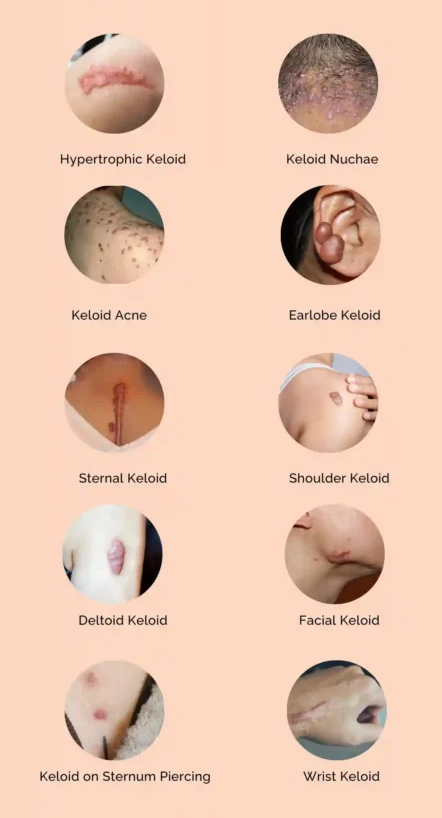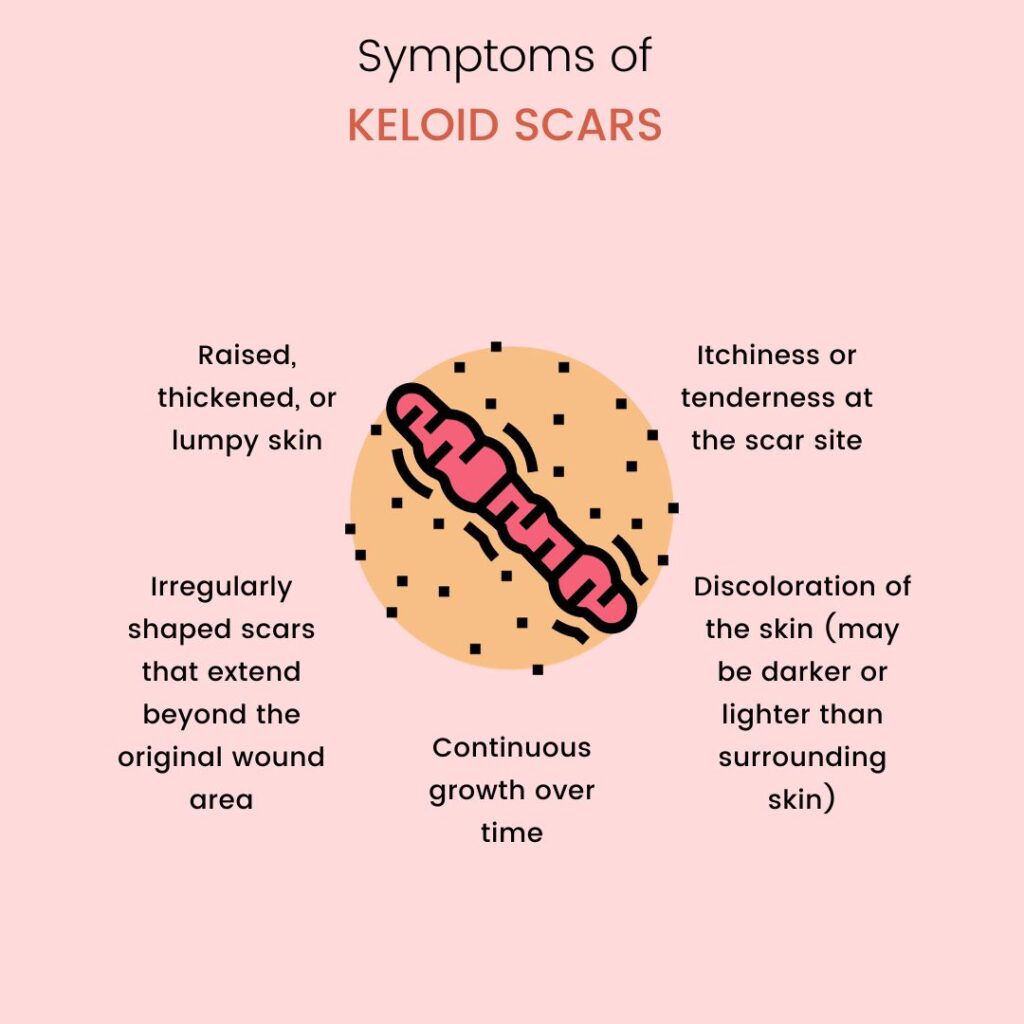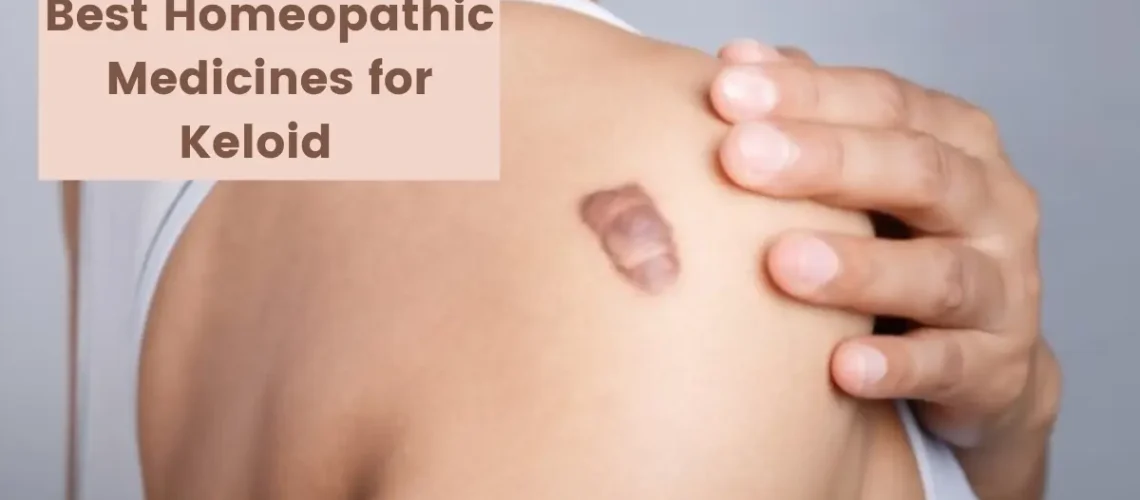This blog explains the best homeopathic keloid medicines for removal, their causes, symptoms & best treatment.
Keloid is scar tissue. It is not dangerous for health but produces disfigurement. Keloid is the overgrowth of healing tissue after injury, burns, and surgery.
Keloid is known as fibrotic tumors. Keloids develop commonly at the central chest, back, shoulder, and ear lobes. It affects both males and females similarly. Asian descendent are more commonly prone to keloid growth.
Keloid was first registered under the surgical techniques in the Smith Papyrus by an Egyptian surgeon around 1700BC.
Table of Contents
ToggleTypes of Keloids:
As per the appearance of the keloid, it is classified as follows:
1. Fresh Nodular Keloid:
Fresh keloid that is firm, fresh, mature, or growing slowly, pink in color. It is accompanied by itching and pain.
2. Butterfly Keloid (Superficial):
Keloids spread at the scar tissue. These are the superficial layer of the scar with a flat appearance and central regression of tissues.
3. Mature keloid:
Old keloids present for a longer duration without further growth and pain. A patient complains of mature keloids at the site of surgery. It appears deep brown.
4. Multiple keloids:
Keloids present at multiple sites or aggregation of small keloids at one place.

Keloids Causes:
The exact pathogenesis is not known about keloid. Collagen is a protein that is necessary for the wound healing process. If a body tends to produce excessive collagen, then during the healing process body forms keloids in scar tissue.
Depending upon the nature of injury causative factors of keloid are as follows:
1. Burn injury:
After a burn injury, patients with keloid tendency can develop multiple keloids.
It is a dark or pink color with pain and itching
2. Insect stings or bites:
Insect stings produce punctured wounds and during the healing process, a single keloid develops at the site of injury.
The most affected areas are the hands, legs, and face.
3. Mechanical injuries:
Injuries, scars produced after a fall or accident. Small injuries during the haircut, shavings, and nail cutting can be a causative factor for a keloid formation.
4. Surgical injuries:
After a surgical treatment like cesarean and hysteroscopy, patients can develop keloids.
Keloids at the site of the suture are one of the complications of the surgery procedure.
5. Genetic causes:
People from Asia, Latin America, and sub-Sahara Africa are prone to keloids.
The family history of keloid is an important causative factor. If a person has a family history of keloid, then he is likely to be predisposed to keloid formation.
Keloid Symptoms
Overgrowth of scar tissue, pain, and itching are characteristic symptoms of any keloid.
Keloid has no harmful effects on health, but a person may feel discomfort about their look with keloids on the face, neck, hand, or leg.
Keloid has different colors. New keloid growth appears pinkish, fresh red on the contrary old mature keloids appear in deep brown.
Pain and itching are subjective in the case of keloids. Patients may feel pain with scar tissue e.g., keloid after burn injury, after a surgery. Patients may experience severe itching and discomfort at the site of the keloid.
Thick, irregular growth of scar tissue is a prominent symptom of keloid. Several types of keloids are there depending on their formations: Flat surfaced, butterfly-shaped, clusters of keloids, lump-like overgrowth.
Keloid has different textures like a firm, soft and rubbery. New keloids are soft and old keloids are firm in nature.
Depending on the location, keloids are present in the ear lobe, mid-chest region, feet, hands, stomach, and face parts of the body.

Risk Factors for Keloids:
Risk factors of keloids are personal history, family history, genetic factors, and skin color.
1. Personal History
If you have a history of keloid formation at the injury site, then it is possible to reappear keloid.
2. Family History:
If your mother, father, brothers, or sisters tend keloids, then you are susceptible to keloid formation.
3. Genetic Factors:
This is the most important risk factor as Asian, African and Latin Americans are more prone to keloid formations.
4. Skin Color:
Black and brown skin color have more tendency to form keloids after an injury. The reason behind it does not know.
5. Age:
Younger People, below age 30 are more likely to be predisposed to keloids. So, if you are below age 30 then, take care of your skin.
Diagnosis of Keloid
Every patient complains of different symptoms. Keloid diagnosis depends on signs, symptoms, personal history, and family history.
Look and growth of unwanted scar tissue help to diagnose keloids.
If a patient has a history of injury, insect bites, or surgery. He complains of unwanted growth of scar tissue at the site of injury. It is easy to identify this case as a keloid patient.
If a patient complains of old keloid growth with pain and itching, then skin biopsy helps to differentiate keloid (fiber tumor) from cancer growth.
Some patients complain of itching, discomfort, and pain with keloids.
Keloids Management:
Prevention is better than cure is apt for keloids. If it is inevitable, then homeopathy treatment, use of topical lotions, laser, and surgery are treatment options for keloids.
Preventive Measures:
1. Prevent skin from injuries:
It is not always possible to protect skin from injuries. If you do not want keloids then try to avoid any mechanical injuries like injuries during shaving, haircut, or tattoo piercing.
2. Wound care:
If you have any injuries then take care of them. Apply petroleum jelly and coconut oil to the affected part. Talk with your doctor about your keloid tendency, he might recommend pressure techniques like applying a pressure pad or silicone gel pad to a wound.
3. Surgery pre-care and post-care:
If your doctor recommended surgeries for any health conditions, discuss with him your keloid disposition. A surgeon can use different surgical techniques to reduce the chances of keloid formation. Also, he can advise about post-surgery wound care.
4. Protect Skin from Sun heat:
Sun heat makes your skin drier and darker. Both these conditions of the skin are susceptible to keloid formations. Try to avoid going out during sun heat. Wear a protection cover to your body that reduces exposure to sun heat.
Treatment and Management:
One or a combination of two treatments helps to reduce the keloid. Keloid tends to reappear. After surgical removal of the keloid and using cryotherapy, the keloid may reoccur with a new injury.
Treatment options are as follows:
1. Apply pressure bandage and topical lotion:
Use pressure pads and fabric material on the wound during the healing process. This might be a little discomfortable because you must apply this bandage for 10-12 hours per day for 4 to 6 months.
Use of corticosteroid ointment to the wound to reduce itchiness and pain. Apply petroleum jelly to soften the scar tissue of the wound site.
2. Surgery:
If no treatment is helpful, then the doctor will remove keloids with help of surgery. But the recurrence rate of keloid after surgery is 45-100%.
3. Cryotherapy:
Cryotherapy uses liquid nitrogen to freeze small keloids. It reduces the size of the keloid. Repeated treatment is necessary. A patient complains of pain, loss of skin, and blisters at the site of treatment.
4. Laser therapy:
Laser therapy helps to flatten the keloid and reduce itching. A doctor recommends sessions of laser therapy for 4-8 weeks. A patient complains of hypopigmentation and pain after this treatment.
5. Radiation therapy:
This therapy is useful after keloid surgery. Radiation helps to reduce scar tissue at the surgery site.
These treatment options are available but total removal of the keloid is not possible with these options.
Best Homeopathic Keloid Medicine
Homeopathy remedies, lotions, creams, and oils are helpful to treat keloid tendencies. Homeopathy treats disease conditions and patients. Therefore, it can reduce your tendency to keloids.
Keloids belong to the tendency of a person towards abnormal healing tissue. Homeopathy needs family history, personal history, characteristics of current complaints, and modalities for a complete cure.
There are certain homeopathy ointments available that help to reduce growth, make keloid soft, and reduce itching and pain. Some remedies help to arrest the growth of the keloid, may be useful for wound care, and may treat the keloid tendency of a person.
1. Antim crud: – For thick, hard keloid growth with itching
Antim crud is good for thick, hard skin growth with itchiness. A patient complains of more itchiness at night. The patient’s skin is dry in nature.
Dose and Potency:
Antim crud is useful in lower potency like 6C, 30C. 4 globules three times per day for 3-4 days. Use Antim crud cream for external application.
2. Arnica: – for wound care after an injury
Arnica is indicated for injury. External application of arnica cream or lotion produces soothing effects. It reduces itchiness and pain. And avoid further complications.
Dose and Potency:
Arnica is useful in lower potency like mother tincture, and 30C.
Mother tincture (Q), 5 drops in coconut oil or lotion apply externally 3 times per day.
3. Calcarea Sulphurica: – For delayed healing of wounds
Calcarea sulphuric is indicated by cuts, wounds, and bruises. A patient complains of delayed healing with pus or discharge. Calcarea sulph is useful in keloid patients to avoid further delay in wound healing and avoid keloid formation.
Dose and Potency:
Calcarea sulph 12 X is useful internally, take 4 globules 3 times a day for 15 days. Apply a mixture of Calcarea sulph 3X trituration and coconut oil externally on a wound.
4. Calcarea Fluor: – for scar tissue, hard keloid after surgery
Calcarea fluor is indicated for scar tissue after surgery. Healing injury has hard swelling that is surrounded by pink, and purple skin. This remedy is useful to resolve keloid or arrest the growth of keloid.
Dose and Potency:
Calcarea fluor is useful in 6X or 12X potencies. Take 4 globules 3-4 times per day for 2 months.
5. Cantharis: – useful for wound care after burns
Cantharis is useful to prevent scalds after burns. External and internal use of cantharis in burn cases helps to reduce complications like a keloid. A patient complains of burning pain.
Dose and Potency:
Cantharis is useful in lower potencies like 3X, 6X, and 30C. Take 4 globules of 30C three times per day. Apply a mixture of 3X and water externally to the wounds.
6. Calendula: – Useful for wound care
Calendula is indicated for wound care. It enhances the healing process and keeps the skin soft. Calendula helps to reduce the chances of keloid formation.
Dose and Potency:
Calendula is useful in lower potency like 3X and mother tincture. Use externally and internally for better results. Take 4 globules of 3X, three times a day for 2 days with the use of Calendula lotion externally.
7. Fluoric acid: – Useful for itching of old keloids
Fluoric acid is indicated in dry, harsh, itching, and cracked keloid. Keloid is red in color with severe itching, which aggravates by warmth application.
This is one of the important remedies to reduce and avoid the growth of keloids. Mostly use Fluoric acid with Silicea, like complementary medicines.
Dose and Potency:
Fluoric acid is useful in lower potency like 6C, 30C, and 12X. Take 4 globules 3 times a day for 8-10 days.
8. Graphites: – for the early stage of Keloids
Graphites is indicated for the early stage of keloids. It is suitable for unhealthy skin. Skin is hard, rough, and dry.
A patient complains of unhealthy recovery of any skin injury. This remedy acts as a constitutional remedy. Graphites helps to reduce the tendency of keloid formation in children.
Dose and Potency:
Graphites is useful in lower potency like 6C and 30C. It is available in cream and lotion format. Apply cream or lotion externally to the keloid and take 4 globules every morning per day for 10-15 days.
9. Nitric acid: – for hard, cracked and cauliflower like keloids
Nitric acid is indicated for unwanted granulation at the injury site. It is suitable for hard, dry keloid that looks like cauliflower. Keloids have irregular shapes and edges. Its base is dry and bleeding sometimes. A patient complains of itching and splinter-like pain.
This is the best remedy for old keloids. Old keloids are painful in the winter season. Crusts are formed during the healing.
Nitric acid can be used along with Thuja and Calcarea fluor for better results.
Dose and Potency:
Nitric acid is useful in 6C potency. Take 4 globules 3 hourly for 8-10 days.
10: Pulsatilla– for the first stage of keloid
Pulsatilla is indicated for the new formation of keloids. Keloid is hard in nature with red color. Keloids form after insect bites and after scratching.
Pulsatilla is useful for adolescent girls who have pimples and acne. Keloid is formed at the scar tissue of acne and pimples.
A patient complains of severe itching. Pulsatilla is a good constitutional remedy. It reduces the keloid tendency.
Dose and Potency:
Pulsatilla is useful in 30C potency. Take 4 globules 2-3 times per day for 10 days.
11. Sabadilla: – for a foot keloid
Sabadilla is indicated for cracked, dry skin underneath the toenail.
The toenail is thick and has unwanted fibrous tissue growth around it.
A patient complains of swelling and pain in the feet region.
This is a good remedy for old keloids in the feet toes region.
Dose and Potency:
Sabadilla is useful in 3X and 30C. Take 4 globules 3-4 times per day for 8-10 days and apply mother tincture mixed with oil externally.
12. Silicea: – for keloid growth
Silicea is an excellent remedy for keloid growth. One of the best remedies in homeopathy. It is indicated in keloid growth from the mid-chest region and at the back of the body.
Silicea in large doses helps to absorb the extra fibrous tissue into the skin. A patient complains of pain with keloids.
This remedy is useful to reduce the keloid tendency.
Dose and Potency:
Silicea is useful in higher potency like 200C and 1M. Take 4 globules at night for 10-15 days.
13. Sulphur: – for recurrence of keloids
Sulphur is indicated for dry, burning eruptions with severe itching that aggravates at night. Skin is dry and unhealthy. Every little injury takes time for healing.
Keloid is painful and soft in nature. Keloids form after every little injury. A patient complains of burning and itching that aggravates after scratching at night.
Sulphur is a great anti-psora constitutional remedy. It is useful to reduce the keloid tendency.
Dose and Potency:
Sulphur is useful in 12C and 30C. It is available in cream and lotion forms. Take 4 globules every evening per day for 8 days and apply cream or lotion on the affected parts.
14. Thiosinaminum: – for dissolving keloids
Thiosinaminum is indicated for dissolving scar tissue from unwanted fibrous tissue growth. It has a special affinity for ear lobe tissues. Therefore, it is useful to reduce the earlobe keloid.
Dose and Potency:
Thiosinaminum is useful in lower potency like mother tincture and 3x. Take 4 globules of 3X, 2 times per day for 10-15 days. Inject the solution of water mix with 10-15 drops of mother tincture at the site of the lesion, 2 -3 times a week.
15. Thuja: – for recurrence of keloids
Thuja is indicated for dry skin and a tendency for keloid recurrence.
Thuja helps to dissolve the keloid. A patient complains of growth in scar tissue, brown in color with itching. Itching aggravates after touch and scratching.
Thuja is a great anti-sycotic remedy. This is helpful to reduce the keloid tendency of a patient.
Dose and Potency:
Thuja is useful in lower potency like mother tincture and 30C. Take Thuja 30C, 4 globules early in the morning for 10 days. Apply thuja mother tincture on keloids 3 times a day for 15-30 days.
Remember that homeopathic remedies should be prescribed based on individual symptoms and characteristics. It’s crucial to consult with a qualified homeopath for proper evaluation and personalized treatment. Homeopathy focuses on treating the whole person, so a detailed case study is necessary to select the most appropriate remedy.
Homeopathic medicines should be taken only when prescribed by a homeopathic physician. Self-medication may aggravate the original conditions.


4 thoughts on “15 Best Homeopathic Keloid Medicine – Removal & Treatment”
Keliod
Shakhapur Village
Pangal mandal
Wanaparthy DIST
Telangana state
This post is extremely radiant. I really like this post. It is outstanding amongst other posts that I’ve read in quite a while. Much obliged for this better than average post. I truly value it!
This post is extremely radiant. I really like this post. It is outstanding amongst other posts that I’ve read in quite a while. Much obliged for this better than average post. I truly value it!